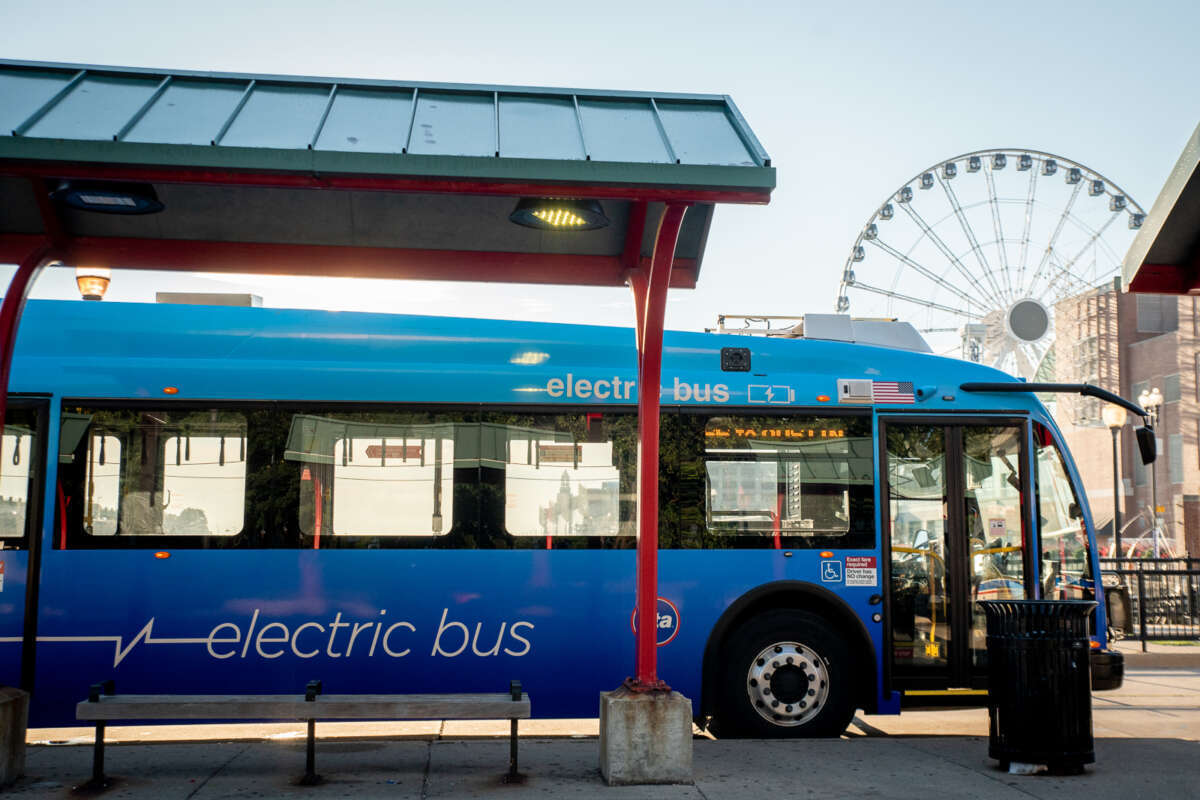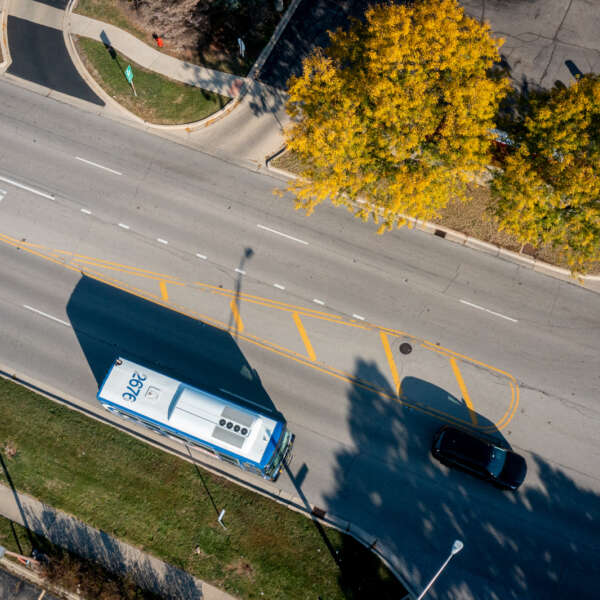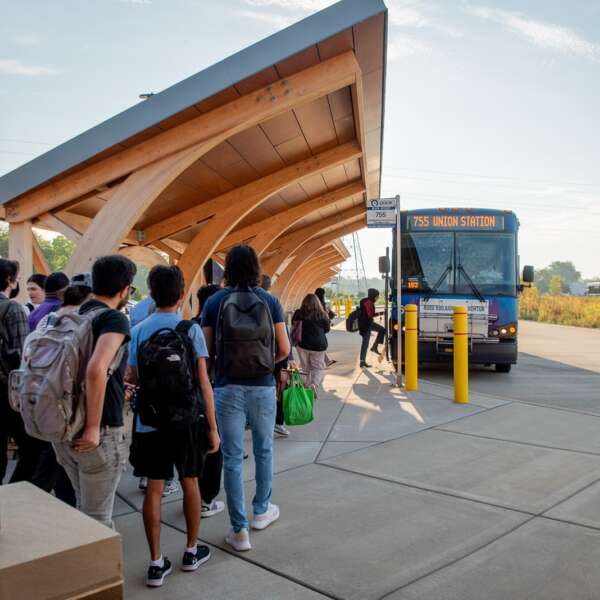RTA advocates for transit-priority, BRT to be included in major Chicago roadway projects
August 28, 2024
August 28, 2024

Dedicated space on roads for Pace and CTA buses is critical to improving speed and reliability. It will take a coalition to inspire the political will within the highway and road agencies to build more transit-friendly streets and bus rapid transit (BRT) in the Chicago region. In Transit is the Answer, the RTA committed to advocate for BRT and in recent months the agency has worked to be a vocal supporter pushing our partners to make progress.
BRT is fast, reliable bus service featuring dedicated lanes, bus-priority traffic signals, and enhanced stations. It’s more affordable and less disruptive than building new rail lines, allowing growth of a BRT network and stations to advance much more quickly. Dedicated bus lanes can help free buses from congestion while making streets safer for all users by slowing cars to safe speeds through the narrowing or eliminating of general-purpose lanes.
Compared with peer regions, the Chicago region dedicates very little roadway space for public transit. Transit agencies serving cities like Los Angeles, Seattle, Miami, Minneapolis, Houston, and Phoenix all have over 100 miles of transit-only or transit-priority roadway lanes. Chicago has less than 15 lane miles in this category, not including bus-on-shoulder corridors on regional expressways.
This year, RTA has sent letters, met with partners at CDOT and IDOT, and testified at public meetings to encourage transit-priority to be included in major transportation projects.
On North DuSable Lake Shore Drive, the RTA recognizes that the rebuild is a monumental opportunity for the lakefront and the region and has advocated to include transit riders in that vision.

“We have a once-in-50-years opportunity to redesign this corridor to serve all the region’s residents and not just drivers. We must seize this moment to prioritize the tens of thousands of daily bus riders who make this one of the most heavily used transit corridors in the entire RTA system,” wrote RTA Chairman Kirk Dillard in a letter sent to CDOT and IDOT in July. “The 69,000 daily bus riders on 3,300 CTA bus trips deserve faster and more reliable service that can grow ridership in the future and serve even more people. The Chicago region and particularly the City of Chicago lag the nation in creating dedicated space for buses. We urge you to incorporate best practice, multimodal bus, and bike priority into the NDLSD corridor, and reject alternatives that will enhance or worsen the status quo.”
The project team’s current preferred design includes minimal bus priority treatments on entry and exit ramps. RTA is joining with advocates and Lakefront lawmakers in urging planning officials to reconsider and advance a design with dedicated bus lanes on the main corridor.
Similarly, in March, the RTA responded to public comments asking for the RTA to encourage transit-priority as part of the Chicago Avenue Bridge and Halsted Street reconstruction.

“The planned reconstruction of the Chicago Avenue River Bridge and redesign of the nearby Chicago Avenue and Halsted Street intersection is a critical opportunity to boost bus speed and reliability by incorporating fully dedicated bus lanes in both directions,” wrote Chairman Dillard in a letter to CDOT in March. “The latest proposed design that contains minimal bus priority treatments is not sufficient to result in meaningful service improvements and does not align with our shared vision to improve travel times on high-ridership bus routes.”
The letter noted that the #66 Chicago and #8 Halsted routes were the two highest ridership CTA bus routes in 2023, each averaging more than 15,000 trips per day. Ridership on these routes has grown more than 40 percent over the last two years, but survey data shows many bus riders continue to be frustrated by slow and unreliable services. Too often a crowded bus gets stuck in traffic alongside many single occupancy vehicles, delaying travel times and making it less likely people will choose to ride the bus. This issue on Chicago and Halsted is likely to get worse in the coming years with the arrival of the Bally’s Casino and related developments.
In response to the letter and persistent advocacy from residents and community groups, CDOT updated the design with enhanced bus and bike lanes. The plans now include wider bikeways and dedicated bus lanes throughout the Chicago Avenue segment of the project. Previous plans included only queue jump bus lanes in and out of the Chicago/Halsted intersection.
RTA is advocating for the implementation of bus rapid transit on key corridors across the region. On July 29th the Chicago City Council’s Pedestrian and Traffic Safety Committee hosted a hearing on bus priority infrastructure featuring presentations from CTA and CDOT. The agencies discussed recent improvements to the bus rider experience in the city and plans for further upgrades. RTA provided a public statement in support of building BRT on the Western Avenue corridor, a long-discussed project being championed by local alderpersons and advocacy groups.
“Western Avenue is one of the busiest bus corridors in the Chicago region, with more than 20,000 rides per weekday and connections to four CTA rail lines and one Metra line. These riders deserve fast and reliable service on their way to work, school, healthcare centers, and visits with family and friends. Building BRT on Western is an efficient way to upgrade service, boost the local economy, and improve quality life in surrounding neighborhoods.”
RTA is supporting Pace in their plans for a network of Pulse Rapid Transit Service on major arterial streets in the suburbs, which requires partnership with IDOT and local municipalities. In August 2019 Pace launched Pulse Milwaukee Line, serving thousands of commuters between Niles and Chicago. The Pulse Dempster Line started in August 2023 bringing fast, frequent service between Evanston and O'Hare Airport. Pace average weekday bus ridership on Dempster was up 34% year-over-year in June.
Plans are in development to bring Pulse service to Halsted, 95th Street and Cermak.
Local and state transportation departments control the streets and have the final say in roadway design, but our region needs to work collectively to accelerate and fund bus priority projects to catch up with peer regions. The RTA will continue to champion bus projects and advocate for other agencies to dedicate more street space to high-quality bus service.
You can help by joining RTA’s Transit is the Answer Coalition. The group of riders, advocates, and representatives from the CTA, Metra, Pace, and other government agencies meets quarterly to pursue strategies for strengthening the transit system and making it more useful for all residents – including advancing BRT. Individuals and organizations are welcome to join and can sign up now to receive updates.
Subscribe to our Newsletter
Related Articles
 Coalition members provide feedback on ‘Transforming Transit,’ RTA’s vision for improved service and accountability
Coalition members provide feedback on ‘Transforming Transit,’ RTA’s vision for improved service and accountability
Nearly 200 riders, advocates, and other stakeholders met virtually with the RTA on February 11 for the sixth quarterly Transit is the Answer Coalition meetin...
February 20, 2025 Far South Halsted Corridor Study prepares for future Pace Pulse service
Far South Halsted Corridor Study prepares for future Pace Pulse service
An RTA Community Planning project kicked off in late 2023 as a crucial step in bringing Pace Pulse service to Chicago’s south suburbs. The Far South Halsted ...
February 19, 2025 RTA proposes reforms to prioritize capital projects, maximizing impact of funding
RTA proposes reforms to prioritize capital projects, maximizing impact of funding
RTA is proposing a historic restructuring of the region’s transit governance to maximize the impact of new operating funding and ensure all riders experience...
February 5, 2025 RTA proposes reforms to integrate fares, require accountability for faster and more reliable transit
RTA proposes reforms to integrate fares, require accountability for faster and more reliable transit
RTA is proposing a historic restructuring of the region’s transit governance to maximize the impact of any new operating funding and ensure all riders experi...
February 5, 2025 For the third year in a row, regional transit ridership was up by double-digits in 2024
For the third year in a row, regional transit ridership was up by double-digits in 2024
Ridership across the Chicago region’s transit system continued to increase throughout 2024, according to the latest data from CTA, Metra, and Pace. The regio...
January 28, 2025 RTA is seeking $1.5 billion in annual operating funding. What would that mean for your commute?
RTA is seeking $1.5 billion in annual operating funding. What would that mean for your commute?
On January 15, RTA released Transforming Transit, a vision for the regional transit system with $1.5 billion in annual operating funding supported by a stron...
January 28, 2025